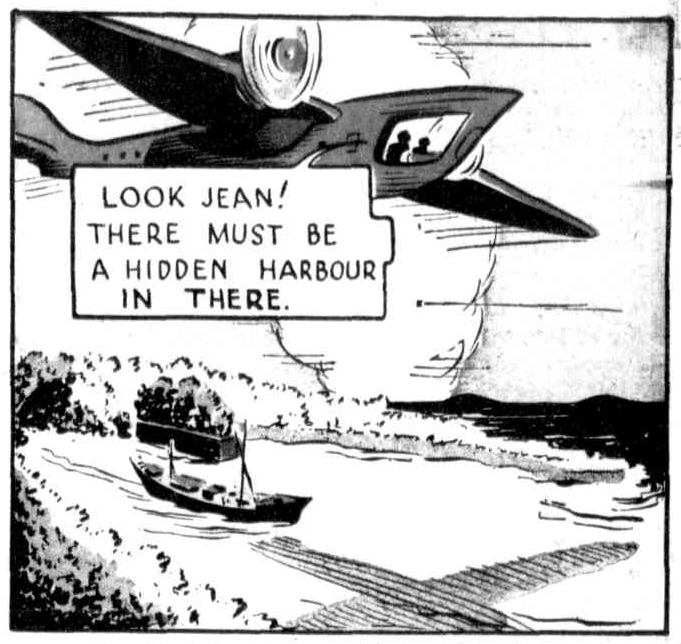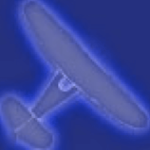
When is an mystery aeroplane panic not a mystery aeroplane panic? When it’s a mystery sampan panic, obviously.
This post started with an article found by @TroveAirRaidBot, published in October 1934, reporting that a Japanese Foreign Ministry spokesman ‘feared that recent rumours in Australia regarding Japanese naval activities, also mystery aeroplanes in Northern Australian waters, were mischievous attempts to poison Australian-Japanese friendship’.((Canberra Times, 13 October 1934, 4. Elsewhere he is identified as a ‘Mr Amau’: Mercury (Hobart), 15 October 1934, 8.)) It’s rare for mystery aeroplanes to rise to the level of international relations, since in those cases where suspicions are raised about the responsibility of a foreign power it’s usually not dignified with a response by the power concerned. Here, the comment was made in the context of the detention of a Japanese steamship off New Guinea, then an Australian colony (sorry, mandate). The steamship, named as ‘Yocikine Maru’, was found to have its holds full of trochus and green-snail shells, valuable marine commodities the harvesting of which was strictly regulated by Australian fisheries regulations.((Argus (Melbourne), 12 October 1934, 10.))
What of those mystery aeroplanes, though? This relates to an incident a month earlier. The ketch Thistle reported having seen ‘an unknown sampan’ with ‘several boats out […] apparently gathering shell’, somewhere near Thursday Island, one of the Torres Strait Islands between New Guinea and Australia. The Thistle ‘also sighted two planes flying not far from the Sampan’ and the suggestion was made that these were ‘look-outs’ (for what? Shells? Officials?)((Glen Innes Examiner, 8 September 1934, 1.)) Another, fuller and apparently independent account of the aeroplanes doesn’t mention the Thistle at all, but instead cites three other fishing boats, all out of Thursday Island. This Land, captained by Mathias Remedio, encountered only the sampan (‘about 40 tons’, ‘painted black’ with ‘eight boats like canoes, each with not fewer than five men’) at Cairncross Reef. The aeroplanes were reported (via Remedio) by John Alce and the Spider:
Those aboard the Alce heard on Tuesday [4 September 1934] the roar of engines, and then saw two planes flying north-easterly and passing to the eastward of the Alce. The crew of the Spider also saw the planes. They watched them pass out of view towards Milman Island.
The RAAF reported that no Defence Department aircraft were anywhere nearby. The Sunday Mail headlined its article ‘FOREIGN INVASION OF BARRIER REEF’.((Sunday Mail (Brisbane), 9 September 1934, 2.))
All very dramatic, but while the sampan panic kept on going, the mystery aeroplanes seem to largely have dropped from view after that. Stories in October headlined ‘MARAUDING SAMPAN’ and ‘THE DEFENCELESS NORTH’, about a station on Haggerstein Island which, it was claimed, was looted in early September by a sampan’s crew while the overseer was absent, make no reference to the black sampan and its aerial lookouts, even though it was in the same area at the time.((Cairns Post, 8 October 1934, 7; Townsville Daily Bulletin, 8 October 1934, 4.)) The press reports are replete with complaints about government inaction, state and federal. The Queensland government did send its own ketch, Melbidir, loaded with police, out to search for sampans. But it found nothing and was anyway too slow to intercept anything if it had done.((Courier-Mail (Brisbane), 7 November 1934, 15; Cairns Post, 9 November 1934, 6.))
Stepping back a bit, there were many mystery sampan stories in the Australian press throughout the 1930s. Most, if not all, were probably real enough, as some were detained and there was already a history of (at least partly legitimate) Japanese involvement in the trochus and bêche-de-mer industries in Australia’s north.((Though sampans aren’t a characteristically Japanese type of watercraft, nor would they have been ocean-going enough to regularly travel from the nearest Japanese ports in the Carolines, which is a great circle distance of over 2200km (and through New Guinea). But 1930s Australian journalists probably weren’t that particular.)) In fact, many of the stories seem to have economic fears at their heart, rather than strictly defence ones, perhaps not surprising in the aftermath of the Depression. Remedio, for example, protested that ‘local workers were prevented from picking up young, small trochus shell, which was of greater market value, while the Japanese took everything, and soon there would be nothing left for any one’.((Sunday Mail (Brisbane), 9 September 1934, 2.))
But then again, economics and defence have long been mixed up, along with race, when it comes to the ‘Empty North’ — empty of white European stock, that is. Pam Oliver, in her excellent book, Raids on Australia, identifies a confluence between the interests of the local fishing industry (more pearling than trochus/bêche-de-mer, in her account) to protect their own turf, the desire of missionaries to ‘protect’ Indigenous communities from the corrupting influence of Japanese fishermen, and the erratic but powerful attention from southern newspapers who every so often would suddenly get rattled by evidence of Japanese interest in the far north. The Caledon Bay massacre (of five Japanese bêche-de-mer harvesters by Indigenous men) in 1932 suggests that this wasn’t all just a press beat-up. But it was only after the start of the war with Japan that the sampan incursions really began to be interpreted as part of some long-drawn plan to invade or infiltrate.((Pam Oliver, Raids on Australia: 1942 and Japan’s Plans for Australia (North Melbourne: Australian Scholarly Publishing, 2010), 206-212.)) Certainly there’s some contemporary evidence along those lines, from my brief Trove search, such as this 1936 demand for air and sea patrols of the north coast to deter drug smuggling, or this more even-tempered 1938 article by legal academic A. H. Charteris laying out some of the international law aspects of the northern fisheries issue.1 Full-throated panics don’t seem to turn up until the fateful year of 1942, such as this one which looks back to 1934 as the start of the present danger:
Where this sampan menace of a few years ago was concerned it was clear that we had an appeasement policy just as distinct as that of the Chamberlain party, and appeasers who never failed to find some pretext for not offending Japan by a ruthless exclusion of the sampans.
Now, thanks to the Australian appeasers, ‘these little jackals did know, and do know, more of our lonely northern waters than we do ourselves’. Indeed, had the Japanese ‘struck at New Guinea and Australia first instead of at Pearl Harbour, Singapore, Hong Kong, and Manila, the story of appeasement might have had a tragic curtain’!((Sunday Mail (Brisbane), 4 January 1942, 3.))((Incidentally, I was highly amused to note that the author of this particular piece of panic was none other than Roy Connolly, co-author of my favourite knock-out blow novel, Invasion from the Air (1934). Once a scaremonger…))
Again, aviation doesn’t figure very largely in all of this. Even though the 1934 aeroplanes weren’t the only seen to accompany sampans — there was actually a similar report in 1933 — I haven’t found any speculation about where they might have come from, or what they might have been doing, apart from acting as lookouts.((For the 1933 mystery aeroplane, see Western Herald (Bourke), 27 January 1933, 2; Pacific Islands Monthly, 22 February 1933, 32.)) Without knowing a whole lot about Japanese maritime aircraft of the 1930s, I guess it’s possible that it could have been a long-range flying boat or even a shipborne scout, but to what end I’m not sure. For what it’s worth, Oliver argues that while there was definitely Japanese espionage going on in Australia during the 1930s, this was mostly fairly mundane information-gathering confined to the industrialised Sydney-Newcastle area, and certainly did not herald any particularly malign plans.((Oliver, Raids on Australia, 211-212.))
So, nobody in 1934 seems to have been terribly concerned about an aero-sampan panic; it really was just a sampan panic. Sometimes you need to look beyond the mystery aeroplanes to find the real danger lurking beneath.
Image source: Ebagoola, ‘Sampans over Australia’, Telegraph (Brisbane), 20 August 1938, 21. (This is from from a fairly bonkers comic strip serialised in the Brisbane Telegraph in 1938-39 about a couple of plucky young Far North Queenslanders with their own flying boat who trace a mysterious sampan to a Japanese base hidden under an island in the Great Barrier Reef, along with lots of high technology (video conferencing with the Emperor!), lashings of racism (mostly against the local Indigenous people rather than the Japanese, who are portrayed surprisingly positively), and a prospective invasion for oil and minerals, but only if the Europeans don’t cooperate in exploiting it. This list should show most of the strips in order.)
![]() This work is licensed under a Creative Commons Attribution-NonCommercial-NoDerivatives 4.0 International License.
Permissions beyond the scope of this license may be available at http://airminded.org/copyright/.
This work is licensed under a Creative Commons Attribution-NonCommercial-NoDerivatives 4.0 International License.
Permissions beyond the scope of this license may be available at http://airminded.org/copyright/.



